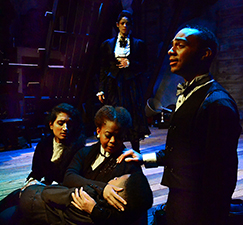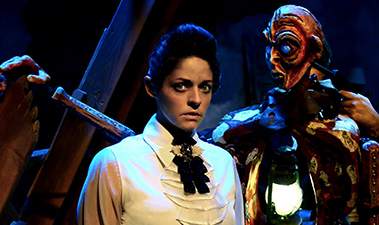From ChicagoOnstage.com
Lifeline’s gender-switched “Frankenstein” is a brilliant, dark take on the original
September 17, 2018
By Karen Topham
★★★★
In this, the 200th anniversary of the writing of the classic novel Frankenstein, there will be no fewer than four distinct productions based on Mary Shelley’s emotional Gothic thriller. The rest of them will need to go a long way to be stronger than Lifeline Theatre’s dark, moody, gender-switched interpretation adapted by Robert Kauzlaric.
Shelley, a feminist herself and the daughter of feminists, a woman who knew much grief in her lifetime as the mother of three children who died young, might have really appreciated this take on her work, in which Victoria Frankenstein (Ann Sonneville) brings the creature to life as a means of trying to bring back her dead father. It is Kauzlaric’s allegorical attempt to deal with the loss of his own father, and it infuses the story with a level of powerful emotion even the original can’t lay claim to: Shelley’s mother did die young, but her daughter hardly new her, and her novel was not an attempt to regain that lost mother (though Victor Frankenstein also loses his) but an attempt to explore what happens when a man decides to play God. (The novel’s subtitle is “A Modern Prometheus.”)
In this new version, staged on a set designed by Joe Schermoly that itself seems broken and shattered and is scattered with many props that will become useful as the story goes on: things that will become the monster, Victoria is almost literally picking up the broken pieces of her life. In her grief, she sets out to use the latest of scientific studies to find a way to reanimate her father, but instead creates a being so hideous to her that she rejects it the instant it is created. The creature is played by a brilliant puppet designed by Cynthia Von Orthal and animated by the actor who played her dead father, Chris Hainsworth. From the start, Hainsworth makes it clear that this is not the benevolent man brought back to life but something new and powerful, something demanding what it will never receive: the love of its creator.
The gender-switching of the main character also enhances the creation myth present in the original: it is females who give birth, and Victoria is therefore the creature’s proverbial “mother,” making her rejection far worse. Sonneville, who narrates the story using (mostly) lines from Shelley’s novel and who is, perforce, onstage for the entire show, gives a performance that is pained and painful: the depth of her character’s loss infuses its every moment, and the horror at what she has done only increases as the creature, to avenge her rejection, begins its terrible spree of murdering her loved ones.
If you’ve never actually read the novel, you might not really know the depth of pain this creature is in. All it wants is “communion” with someone, but its hideous form precludes that possibility. Hainsworth’s portrayal brings the creature’s two sides—both longing and murderous—to provocative life. Its revenge is powerful and deeply emotional, as each one of its victims becomes another puppeteer, another voice, another soul entwined in this awful and awesome creature’s frame, and the more puppeteers that move and speak for the puppet, the more painful it becomes to Victoria to witness it; her sense of loss is multiplied by more than the deaths but by the spirits now haunting her in this outrageous form.
Director Paul S. Holmquist draws out excellent portrayals from all of the actors tasked with bringing this harrowing tale to life: Risha Tenae as Victoria’s bereft mother, Ty Carter as her would-be husband Erich (Elizabeth in the original story), Rasika Ranganathan as her best friend Helena (Henry in Shelley’s novel), Emily Ayre as the horribly doomed Justine, and Trent Davis as Victoria’s young brother William. Each of them also portrays the demon spirits haunting Victoria as she first seeks to build the creature and then seeks to escape it.
Holmquist keeps his pace powerfully quick, and the only times that the 90-minute production slows down are when the creature is assimilating a new soul. Jordan Kardasz’s dim, moody lighting and Barry Bennett’s original music and sound lend an even deeper Gothic element to the whole production, and Izumi Inaba’s costumes—black and a combination of Gothic and Goth—work with the sound and lights to maintain the mood.
As I said, this is the first of four very different takes on the Frankenstein story this year. Remy Bumppo will present one from the creature’s point of view in October, Court Theatre’s November take will be a multimedia presentation blending Shelley’s life with her story, and next spring Lookinglass Theatre will present its own original interpretation. It is the year of Frankenstein in Chicago, and Lifeline Theatre’s gripping, powerful production brings it to a brilliant start.
From Chicago Theater Beat
Mesmerizing descent into madness
September 23, 2018
By Lauren Emily Whalen
★★★½
Grief ain’t pretty.
The older you get, the harder the death of a loved one is to endure. Recently, my uncle’s sudden death brought out not only sadness, but frustration and flat-out boiling anger I thought I’d abandoned long ago. For those of us who don’t respond well to hugging, crying and praying – all very legitimate ways to deal – grief is, to put it mildly, a raging bitch.
The protagonist of Lifeline’s Frankenstein is deep in the throes of grief herself. Intelligent university student Victoria (Ann Sonneville) is thrown for the ultimate loop after the loss of her beloved father. As this is the nineteenth century, Victoria can’t turn to therapy, exercise or antidepressants. (And let’s face it, most people these days still don’t, but the state of mental health in our country is a whole other rant.) Feeling isolated and increasingly manic, she forsakes her studies, remaining family members and loyal friends to build a creature. The results are devastating, terrifying and, to both Victoria and the audience, ultimately rewarding.
Lifeline’s adaptation of Frankenstein is the first of four that will open in Chicago this season. Both Remy Bumppo and Manual Cinema (i/a/w Court Theatre) will debut productions this fall as well, with a Lookingglass Theatre take to premiere in May. All have promised different versions of Mary Shelley’s classic, written when Shelley was only 18 and thought to be the first-ever science fiction novel. Lifeline’s Frankenstein, a world premiere adapted by Robert Kauzlaric and directed by Paul S. Holmquist, boils down the war of human versus monster in a way that’s deceptively simple and alarmingly universal.
You see, Victoria is battling herself.
Watching a character basically have a mental breakdown is thoroughly uncomfortable, just as it should be. Kauzlaric and Holmquist never take the easy way out with a stereotypical “crazy lady” narrative. Victoria may be wild-eyed, often babbling to her bemused siblings and obsessively collecting her father’s talismans, but she doesn’t run around crying and screaming. In truth, she may have had emotional struggles long before her father’s passing. As Shelley herself could probably have testified, being a smart young woman in a society that only expected marriage and babies from its “fairer sex” was challenging on a good day. Still, it’s refreshing to see a sensitive, complex female protagonist in a period piece who isn’t breaking down because of a broken relationship or anything baby-related. Even in 2018, most main characters dealing with their feelings are primarily young, white men. This Frankenstein breaks the mold, in this way and many others.
Fear not, horror buffs: the Monster is very much present, in the form of Cynthia Von Orthal’s uncanny Valley-esque life-sized puppet. He’s strangely articulate, simultaneously appealing to Victoria’s crushing loneliness and berating her for torturing him with their collective existence. Aside from one problematic moment involving the Monster beating Victoria – come on, we already know she’s hurting inside, a creature with a deep masculine voice doesn’t need to whoop and victim-blame her to prove a point – their relationship is a fascinating battle of wits. For most of this Frankenstein, it looks like Victoria will not survive physically or emotionally. Like many cycling through Kubler Ross’s stages of grief, she’s in deep denial, then bargaining with her very life to bring her beloved father back. In this Frankenstein, the heroine, already an outsider before death plunges her into madness, must save herself. And the audience, captivated from beginning to end, can’t help but hope she’ll see the light.
From the Chicago Tribune
‘Frankenstein’ story is a powerful allegory for loss in Lifeline’s adaptation
September 17, 2018
By Kerry Reid
★★★
The Modern Prometheus is getting quite a workout on Chicago stages this year, with three adaptations of Mary Shelley’s “Frankenstein” opening this fall and a fourth in the spring. The obvious reason is that it’s been 200 years since the 18-year-old prodigy published her classic tale. Since then, it’s been worked over and reimagined countless times, with fans of horror, gothic and science fiction all laying equal claim to it as an early progenitor of their respective genres.
The less obvious reason for its appeal is something that Robert Kauzlaric’s adaptation for Lifeline Theatre (the first to open) gets right. In some regards, it’s quite faithful to the outlines of the original. But Kauzlaric’s approach is to treat the story primarily as an allegory for unnatural grief and how it isolates us even from those we love most. As Shelley wrote, “Nothing is so painful to the human mind as a great and sudden change.”
Here, that change comes for Victoria (Ann Sonneville), a young university student thrown into a maelstrom of mourning by the death of her father, Alphonse (Chris Hainsworth). No one can pluck her from that vortex — not her mother, her siblings, her best friend or her lover. Victoria’s desire to re-create what she’s lost ends up costing her everything she still has.
Kauzlaric hasn’t just given us a feminized Victor Frankenstein, though. Sonneville’s Victoria isn’t motivated by the scientific hubris often associated with the original maker of the monster. She just wants to gather up the scraps of detritus left behind by her father and bring him back. (In this, she may not be so different from pet owners who clone the furry loved ones they’ve lost.)
Early on, after returning to school (where she steadfastly avoids answering letters from back home), she notes how odd it is to see strangers moving around her when her own life has stopped dead in its tracks. It’s a simple but profound encapsulation of how grief feels for those in the midst of it.
Director Paul S. Holmquist’s staging initially presents Victoria’s family and friends as a sort of stylized Greek chorus, each representing a different aspect of what she’s shutting out of her life. Mother Caroline (Risha Tenae) is the keeper of the past who writes to her daughter that Alphonse was a man with great flaws as well as great attributes. Her young brother, William (Trent Davis), is innocence personified, while her adopted sister Justine (Emily Ayre) represents faith. Friend Helena (Rasika Ranganathan) is the repository of Victoria’s joy, while lover Erich (Ty Carter) is her future.
The declamatory intonations of the supporting characters as they implore Victoria to reconnect with them stand in stark contrast to Sonneville’s febrile and impassioned volubility as she dissects the bones of loss. But once the monster/father is animated — and threatening them — they become more than allegorical figureheads. Ranganathan and Carter in particular bring notes of sympathy to their portrayals. We see them throwing out lifelines to Victoria even as they struggle with their own confusion and grief.
The monster is a marvel of puppet design by Cynthia Von Orthal, worked initially by Hainsworth, with assists from the other cast members as, one by one, they die at his hands. It’s evocative of Handspring Puppet Company’s collaborations with William Kentridge. (Von Orthal worked with the late great Hystopolis Productions back in the day and has designed for many companies locally and abroad.) The glowing “heart” at its center — a simple lantern — reminds us that the creature is alive and yearning, even as it tears Victoria’s world to shreds.
The other production elements in Holmquist’s staging also work together to suggest the atmosphere of despair driving Victoria’s actions. Joe Schermoly’s rickety-attic set, Jordan Kardasz’s chiaroscuro lighting, and Barry Bennett’s music and sound (elegiac, with well-placed moments of dissonance) capture the brokenness of her world.
Sonneville’s performance meshes beautifully with Kauzlaric’s thoughtful (if at times a tad mannered) adaptation — emotionally engaging without falling into rote histrionics. The truthfulness of her Victoria’s journey through the stages of grief recasts one of the most well-known monster fables into an authentic and sometimes profound portrait of monstrous loss.
From Picture This Post
New Creation from the Depths of Grief
September 17, 2018
By Harold Jaffe
HIGHLY RECOMMENDED
A Bracing Twist on Shelley’s Classic
Lifeline Theatre’s world premiere adaptation of Frankenstein reimagines Mary Shelley’s quintessential novel as the story of Victoria Frankenstein (Ann Sonneville), a university student who has just suffered the unexpected death of her beloved father Alphonse (Chris Hainsworth). As her family mourns and begins the slow, painful process of accepting his passing, she decides that if they are resigned to such “weakness,” she must be strong. It would take a miracle to bring her father back, so she determines to make one.
This determination proves a powerful motivator, but also an isolating burden. Frankenstein returns to school and throws herself into her task. Cocooned in her apartment—Joe Schermoly’s set seems to reflect both the brilliance and chaos of its occupant’s mind—she puts off friends’ and relatives’ entreaties to come home and recover together with them. Instead she constructs a vessel and, with all her memories of her father and pain at his death as fuel, blows into it the breath of life.
Her creation, a human-sized puppet designed by Cynthia Von Orthal and voiced/operated by Hainsworth, squarely occupies the uncanny valley, both grotesque and piteous, humanoid and other. They beg Frankenstein for guidance, acceptance, communion with another living soul; aghast, she rejects them and refuses their pleas. The Creature’s needs and Frankenstein’s refusals feed on each other, building inevitably to further tragedy.
Lifeline Theatre Mixes Hope and Despair
Although Robert Kauzlaric’s adaptation retains elements both of horror and of science fiction, the genre Shelley originated, it is not so much a horror story or a sci-fi story as a meditation on loss and grief. From Victoria’s mother Caroline (principally played by Risha Tenae, ably understudied by Julie Partyka) informing her of Alphonse’s death to the final confrontation with the Creature, a sense of desolation looms. Jordan Kardasz’s crepuscular lighting and Barry Bennett’s elegiac music reinforce and enhance this feeling.
In counterpoint to these manifestations of Frankenstein’s unresolved anguish, a few flickers of brightness peek through. The memories she harnesses as she strives for resurrection appear as literal stars in the sky. Her brother William (Trent Davis), foster sister Justine (Emily Ayre), and companion Helena (Rasika Ranganathan) offer her the consolations of family, faith, and friendship. Both Helena and Victoria’s love Erich (Ty Carter) encourage her: Live. Choose to live.
Yet the light itself takes on a darker aspect as it illuminates the lantern that forms the Creature’s heart. They vow to destroy everything Frankenstein loves, and in her ensuing dread every glimmer in Lifeline Theatre seems sinister. Still she denies them, and they make good on their threat. One by one, the Creature takes away each of Frankenstein’s sources of comfort, each loss compounding the power they hold over her.
To Bear the Unbearable
Lifeline Theatre’s Frankenstein raises complex questions. As parents bring a child into the world, Victoria gave life to her Creature. What, then, is her responsibility to them? To what extent does she owe them communion, understanding, love?
These are challenging enough to answer when the Creature can be boxed away as their maker’s antagonist, an unlovable monster. But Victoria Frankenstein’s creation is not a monster. From this reviewer’s vantage point, they seem to be the very embodiment of her grief: terrifying and destructive when left unacknowledged, but a window to closure—even communion—once accepted.
From Windy City Times
September 26, 2018
By Mary Shen Barnidge
CRITIC’S PICK
Two hundred years ago, Mary Wollstonecraft Shelley, struggling with grief over a series of untimely deaths in her immediate family, told the story of a man’s audacious attempt to overcome mortality by creating a human being in his own image. His hubristic proposal does not end well.
More than a century and a half later, playwright Robert Kauzlaric, struggling with grief over the death of his own father, found in Shelley’s parable a voice for the confusion accompanying upheaval in his immediate universe and the frustration arising from outsiders’ inability to recognize the extent of damage engendered thereby. Now, in 2018, he recounts the story of a woman whose grief over the death of her beloved father compels her to create an imperfect replica of her late sire, assembled from her memories and her refusal to “move on” as her friends and family have.
Kauzlaric’s entry in the season’s unplanned Franken-fest (Lookingglass, Court, and Remy Bumppo also have Frankenstein productions planned) honoring the 200th anniversary of the horror classic’s publication is less an adaptation of Shelley’s neogothic fable than a wholly re-imagined narrative based in an earlier concept. Our heroine is Victoria, a young woman whose emancipated mien and scholarly pursuits were championed by the parent whose loss she feels deeply. The monster conjured by her crippling bereavement is a grotesque mannequin beseeching his surviving kin to endure the sorrow of separation and to embrace its inevitability.
The abstract construct of a single individual’s spiritual journey is not easy to depict visually, but the collective agility exhibited by the ensemble convened for this Lifeline Theatre production weaves its many elements into an unbroken thread leading our heroine (and us) on the turbulent path through depression threatening to engulf both the living and the dead and ultimately, to recovery and acceptance.
Embodying this metaphor is Cynthia Von Orthal’s towering rod-puppet Lazarus whose countenance reflects a myriad of expressions and whose multiple-operated limbs facilitate a dexterity allowing him, at one point, to physically overpower his distraught reanimator, portrayed with steely resolve by Ann Sonneville. Oh, and since an uneasy mind often resembles a mad scientist’s laboratory, a virtuoso tech team supplies a kaleidoscope of hissing lights, eerie music and evocative shadows.
From Chicago Theatre Review
Foolishly Playing God
September 26, 2018
By Colin Douglas
HIGHLY RECOMMENDED
Wisely eliminating the framing narrative from Mary Wollstonecraft Shelley’s original 1818 novel, Lifeline ensemble member Robert Kauzlaric has devised his own original version of the story. This is the first of four Chicago theatrical treatments of this groundbreaking novel that will honor the book’s 200th anniversary. Directed with style and suspense by Paul S. Holmquist, Kauzlaric’s collaborator for their previous Jeff Award-winning 2007 adaptation of “The Island of Dr. Moreau,” this marks the playwright’s return to the world of psychological horror.
Theatergoers who only know this Gothic horror story from the classic Boris Karloff film will be in for a surprise. Inspired by her travels throughout Germany and Switzerland, along with conversations with her traveling companions about science and the occult, the young Mary Shelley had a dream that inspired her famous novel.
In this new, feminist version of “the Modern Prometheus,” Victor Frankenstein becomes Victoria. When her beloved father unexpectedly dies, Victoria scours the scientific journals to learn how to bring him back from the dead. However, despite her efforts to reanimate Alphonse into the handsome man he once was, the creature she creates is hideous. Victoria finallay realizes her mistake at tampering with nature and flees from the monster. She doesn’t anticipate the horror that will accompany his presence, as the creature seeks revenge upon her.
When Victoria’s young brother William is killed by the creature, Justine, her dear friend and the young boy’s governess, is accused of the crime and hung for his murder. Then, in another gender change, Frankenstein’s best friend Henry becomes Helena, and is also killed by the monster. When her mother Caroline dies of grief and fright, Victoria accepts a proposal from Erich, changed from Elizabeth in this version, in the hopes of starting a new life. But when the creature seeks to punish Victoria for not creating a companion for himself, as he demanded, he does so by taking Erich’s life. Thus, Victoria is punished and, like her monster, left alone for foolishly playing God.
As Victoria, Ann Sonneville is beguiling as the strong, intelligent Victorian woman whose life is turned upside down in her determination to bring her beloved father back to life. By playing God, for her own selfish reasons, Victoria unwittingly causes a series of death and destruction that ultimately ruins so many other lives. Dressed in Victorian chic by the gifted costumer, Izumi Inaba, Ms. Sonneville is a fierce heroic presence.
The supporting cast is excellent, especially Chris Hainsworth as Victoria’s father, Alphonse, as well as the primary puppeteer, who almost vanishes into the shadows as he brings the creature to life. Rasika Ranganathan, always a fine addition to any cast, is excellent as Victoria’s friend, Helena. Trent Davis, who dazzled audiences last year as Charles Wallace in Lifeline’s “A Wrinkle in Time,” is terrific as William. Risha Tenae brings an elegant maturity and compassion as Caroline, Victoria’s mother. Emily Ayre elicits sympathy as Justine and Ty Carter strongly lends his love and support to Victoria as Erich.
Lifeline has a spellbinding new hit on its hands. This intriguing, original, feminist retelling of Mary Shelley’s horror classic is presented without an intermission, so as not to break the story’s suspenseful mood. Dynamically directed and artistically elevated by a talented technical support team, this production captivates. Much credit goes to Cynthia Von Orthal for her frighteningly lifelike puppet that represents Frankenstein’s monster. Joe Schermoly’s haunted house-inspired scenic design, embellished by Jordan Kardasz’s eerie lighting effects and Barry Bennett’s dramatic original music and sound design all add up to the perfect Halloween treat.
From the Chicago Sun-Times
Man’s connection to the monstrous feeds ‘Frankenstein’ at Lifeline
September 18, 2018
By Catey Sullivan
★★★
In Lifeline Theatre’s intriguing staging of “Frankenstein,” the titular creature is no brethren to the bolt-necked, flat-headed Herman Munster types that have come to define the star of Mary Shelley’s genre-defining 1818 novel. In Robert Kauzlaric’s adaptation, Frankenstein looks skinned alive. Created by puppet designer Cynthia Von Orthal, he comes to life — or rather, a hideously mutated version of life — as a grotesque, sentient garment worn by dead people.
But for all his monstrousness, the creature’s words go straight to the pulsing need of every human being on the planet: “Hear me. See me. Help me.” The dichotomy embedded in the repeated refrain is profoundly troubling; it captures the essence of humanity, but it’s spoken by a creature who behaves with inhumane evil. That connective tissue between monster and human defines Kauzlaric’s adaptation. If you’re in the mood for macabre self-reflection (and who isn’t, as Halloween displays sprout like wild witch hazel?) “Frankenstein” is worth checking out.
Directed by Paul S. Holmquist, Kauzlaric’s adaptation flips genders (Shelley’s Dr. Victor Frankenstein is now Victoria; best friend Henry is Helena; fiancé Elizabeth is Erich). The shift brings additional complexity to the original tale. Shelley wrote of a father and son (Dr. Frankenstein and the creature). Lifeline’s story is of a bereaved daughter (Victoria) seeking to bring her father (Alphonse) back to life. When the grieving Victoria (Ann Sonneville) summons Alphonse (Chris Hainsworth) from the grave, she creates a being who is both her father and — since she created him — her son. Ponder the familial intricacies and you’ll soon be down a dark rabbit hole.
But Kauzlaric stumbles significantly with the ending, which is the antitheses of Shelley’s dire finale. At Lifeline, Victoria eventually arrives at a place of empowerment, light and love. It’s an ending that seems like it wandered in from another story entirely. (“Jonathan Livingston Seagull” comes to mind.) It’s incongruous and wholly inconsistent with everything that’s come before it.
Still, there is much to recommend “Frankenstein.” For one, there’s that monster. With Hainsworth manipulating Von Orthal’s creation, the birth of the creature doesn’t need cheesy lightning bolts to heighten the drama. As in the novel, Victoria’s unholy creation is burdened with unbearable loneliness, an unhappiness so intense it leads to savagery. Lifeline’s monster literally engulfs his victims, pulling them up from the grave and enfolding them into the flickering heart of his being. In the end, the puppet contains half a dozen victims, creating a visual that evokes the multi-armed powers of Shiva the Destroyer.
The production is pocked with moments that startle and alarm. Here’s Victoria’s lover Erich (Ty Carter) on surviving harrowing trials: “I won’t tell you we’re only given what we can manage,” Erich says. “We both know that’s a lie.”
Equally dark is the question that inevitably rises from Victoria’s actions: If monstrousness is the result of having to bear the unbearable, aren’t we all potentially monsters? In showing how Victoria deals with impossible sorrow, Kauzlaric makes it clear that monstrousness and humanity are inextricably linked. Monsters aren’t the other. They are us. It’s a chilling premise.
Holmquist’s cast does well by the demanding story. Sonneville’s Victoria ably captures a woman whose lethal emotions have metastasized and poisoned her entire being. Hainsworth brings both Alphonse and Von Orthal’s creation to life. Trent Davis is heartbreakingly vulnerable as Victoria’s doomed little brother, and Risha Tenae captures the bottomless grief of a mother dealt the worst possible blow.
Joe Schermoly’s set design is a decaying gothic delight, complete with a grave that opens like a yawping mouth. And take note of Jordan Kardasz’s macabre, otherworldly light design. Look up: Eels of Borealis-green and indigo slither from the fly space. It’s a wondrous effect within the shadowy world of the play.
Make sure to listen: The creature’s “see me, hear me, help me” refrain is intensified by composer Barry Bennett’s haunting sound design, which incorporates the panic of bird flocks in startled flight, thrumming electrical currents and an undertow of strings just discordant enough to make you uneasy.
It’s never pleasant to confront the monster within. But at Lifeline, it’s eerily entertaining.
























